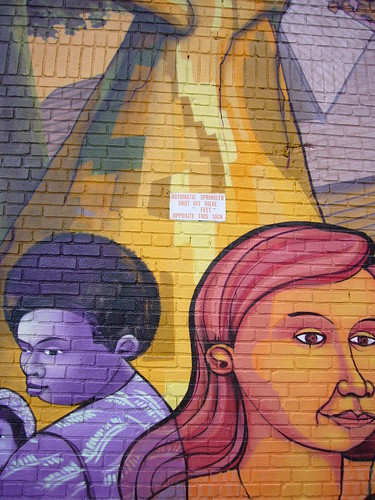
As my last post stated, it'd sure be nice to be driving a car through Rodney, Mississippi and exploring its abandoned Civil War-era buildings and imagine what life was like there way back when. But one's inability to travel to other cities, states, and countries doesn't have to hinder his or her's ability to have meaningful adventures. That's what I love about "urban exploration", a term that I personally use in a broad sense.
In 1990, Ten Speed Press published The Urban Adventure Handbook by Alan S. North. North expressed, both in the Handbook and in a subsequent interview, that "The Call of the Wild" is strong for him and that exploring a city is what he suggests as an alternate to when one can't get to nature. Nonetheless, his Handbook covers a wide variety of urban activities in a moderately thorough manner: Buildering, Balancing (predominantly on slack chains), Urban Adventure Bike Riding, Urban Spelunking, and Going High (climbing towers, bridges, high-rise buildings, monuments, etc.). To North, Urban Adventure is about taking risk, but the rewards are great:
Going on URBAN ADVENTURES will change the way you see your urban environment. The structured, asphalt-and-concrete, developed world will become your wilderness playground. An old brick building will become a choreographer and teach you to dance in a vertical world. The blacktopped, potholed pavement will become a rapids-filled river enticing and challenging the deft navigator. A commuter-choking bridge will become a sculpture to climb. The smelly sewers beneath the city will become a Minoan labyrinth.
The Urban Adventure Handbook is quite possibly the first how-to guide for what is now called Urban Exploration. It is the precursor to Ninjalicious' Access All Areas: A User's Guide to the Art of Urban Exploration. The graphics are funny and helpful, and the book has almost a 1970s vibe to it, even though it's from 1990. Technique, etiquette, equipment, and safety are covered. Advice is freely given.

When you get hauled in for trespassing, etc., don't call your attorney, significant other, or mom at an unreasonable hour. (page 137)
Generally, the water found in drainage systems in polluted. It contains lead, oil, fecal matter, urine, and any garbage that happens to wash down the street. So don't drink it. Operating sewers, in particular, are deadly bacteria-infested environments. (page 118)
If a building management authority asks you to get off of the building, it is best to acquiesce. Agree and leave the site promptly before the law arrives. If you are on a public or corporately owned building, you can always return later when no one is there to bother you, and, correspondingly, you will bother no one. (page 45)
These suggestions may seem obvious or even humorous to you. But sections on Foot Placement (when Buildering), Drafting (during bike riding), and Running a Self-Belay (when Going High) are informative.
I've really enjoyed reading and looking at this book, even though I have no intentions of balancing on a slack chain. The below illustrations by Charles K. Neifeld are particularly humorous and/or accurate.




3 comments:
..One of the women that helped raise me in my extended community when I was growing up knew the guy who wrote this book when they were both kids. In the mid 90's, she received, from of a mutual friend, a brand-new copy, which I read cover to cover. After (recently) graduating college, I found myself occupying rooftops, being homeless in the summer, enjoying solitude and good weather. Only later did I recall some dreams of transformation with connecting themes of escaping crumbling structures, and bequeathing brand-new, empty buildings. I find no small correlation in my childhood fascination with the Teenage Mutant Ninja Turtles, also. I now study Anthropology, Visual Art, Mathematics and Music, and remain fascinated with Urban Exploration, and the interwoven 'safety-mindfulness' that quickly develops in (usually) unique circumstances. Happy to see someone else out there has read this book.
Post a Comment